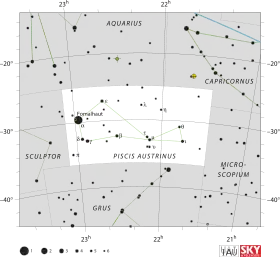Mu Piscis Austrini
Mu Piscis Austrini, Latinized from μ Piscis Austrini, is a solitary,[7] white-hued star in the southern constellation of Piscis Austrinus. It is visible to the naked eye with an apparent visual magnitude of +4.49.[2] Based upon an annual parallax shift of 26.75 mas as seen from the Gaia space telescope, the star is located around 122±2 light years from the Sun.
 | |
| Observation data Epoch J2000.0 Equinox J2000.0 (ICRS) | |
|---|---|
| Constellation | Piscis Austrinus |
| Right ascension | 22h 08m 23.014777s[1] |
| Declination | −32° 59′ 18.3783″[1] |
| Apparent magnitude (V) | +4.49[2] |
| Characteristics | |
| Spectral type | A1.5 IVn[3] |
| U−B color index | +0.02[2] |
| B−V color index | +0.08[2] |
| Astrometry | |
| Radial velocity (Rv) | +11.6±2.8[4] km/s |
| Proper motion (μ) | RA: +71.315[1] mas/yr Dec.: −33.001[1] mas/yr |
| Parallax (π) | 26.7542 ± 0.4513 mas[1] |
| Distance | 122 ± 2 ly (37.4 ± 0.6 pc) |
| Absolute magnitude (MV) | +1.41[4] |
| Details | |
| Mass | 2.06[5] M☉ |
| Luminosity | 24.5[4] L☉ |
| Surface gravity (log g) | 4.00[5] cgs |
| Temperature | 9,034±307[5] K |
| Rotational velocity (v sin i) | 307.7±4.7[3] km/s |
| Age | 412[5] Myr |
| Other designations | |
| Database references | |
| SIMBAD | data |
This star has the spectrum of an A-type subgiant with a stellar classification of A1.5 IVn. It is spinning rapidly with a projected rotational velocity of 308 km/s.[3] This is giving the star an oblate shape with an equatorial bulge that is an estimated 23% larger than the polar radius.[8] An X-ray emission has been detected from this star with a luminosity of 89.6×1027 erg s−1. This may be coming from an undiscovered companion, since A-type stars are not expected to be a significant source of X-rays.[9]
Mu Piscis Austrini is moving through the Galaxy at a speed of 20 km/s relative to the Sun. Its projected Galactic orbit carries it between 23,800 and 28,500 light years from the center of the Galaxy. Mu Piscis Austrini came closest to the Sun 1.2 million years ago at a distance of 111 light years.[4]
Naming
In Chinese, 天錢 (Tiān Qián), meaning Celestial Money, refers to an asterism consisting of refers to an asterism consisting of μ Piscis Austrini, 13 Piscis Austrini, θ Piscis Austrini, ι Piscis Austrini and τ Piscis Austrini. Consequently, the Chinese name for μ Piscis Austrini itself is 天錢四 (Tiān Qián sì, English: the Fifth Star of Celestial Money.)[10]
References
- Brown, A. G. A.; et al. (Gaia collaboration) (August 2018). "Gaia Data Release 2: Summary of the contents and survey properties". Astronomy & Astrophysics. 616. A1. arXiv:1804.09365. Bibcode:2018A&A...616A...1G. doi:10.1051/0004-6361/201833051. Gaia DR2 record for this source at VizieR.
- Drilling, J. S. (December 1971), "UBV photometry of early-type stars in two regions at high galactic latitudes", Astronomical Journal, 76: 1072, Bibcode:1971AJ.....76.1072D, doi:10.1086/111221.
- Díaz, C. G.; et al. (July 2011), "Accurate stellar rotational velocities using the Fourier transform of the cross correlation maximum", Astronomy & Astrophysics, 531: A143, arXiv:1012.4858, Bibcode:2011A&A...531A.143D, doi:10.1051/0004-6361/201016386, S2CID 119286673.
- Anderson, E.; Francis, Ch. (2012), "XHIP: An extended hipparcos compilation", Astronomy Letters, 38 (5): 331, arXiv:1108.4971, Bibcode:2012AstL...38..331A, doi:10.1134/S1063773712050015, S2CID 119257644.
- David, Trevor J.; Hillenbrand, Lynne A. (2015), "The Ages of Early-Type Stars: Strömgren Photometric Methods Calibrated, Validated, Tested, and Applied to Hosts and Prospective Hosts of Directly Imaged Exoplanets", The Astrophysical Journal, 804 (2): 146, arXiv:1501.03154, Bibcode:2015ApJ...804..146D, doi:10.1088/0004-637X/804/2/146, S2CID 33401607.
- "mu. PsA -- High proper-motion Star", SIMBAD Astronomical Database, Centre de Données astronomiques de Strasbourg, retrieved 2017-05-18.
- Eggleton, P. P.; Tokovinin, A. A. (September 2008), "A catalogue of multiplicity among bright stellar systems", Monthly Notices of the Royal Astronomical Society, 389 (2): 869–879, arXiv:0806.2878, Bibcode:2008MNRAS.389..869E, doi:10.1111/j.1365-2966.2008.13596.x, S2CID 14878976.
- van Belle, Gerard T. (March 2012), "Interferometric observations of rapidly rotating stars", The Astronomy and Astrophysics Review, 20 (1): 51, arXiv:1204.2572, Bibcode:2012A&ARv..20...51V, doi:10.1007/s00159-012-0051-2, S2CID 119273474.
- Schröder, C.; Schmitt, J. H. M. M. (November 2007), "X-ray emission from A-type stars", Astronomy and Astrophysics, 475 (2): 677–684, Bibcode:2007A&A...475..677S, doi:10.1051/0004-6361:20077429.
- (in Chinese) AEEA (Activities of Exhibition and Education in Astronomy) 天文教育資訊網 2006 年 7 月 5 日